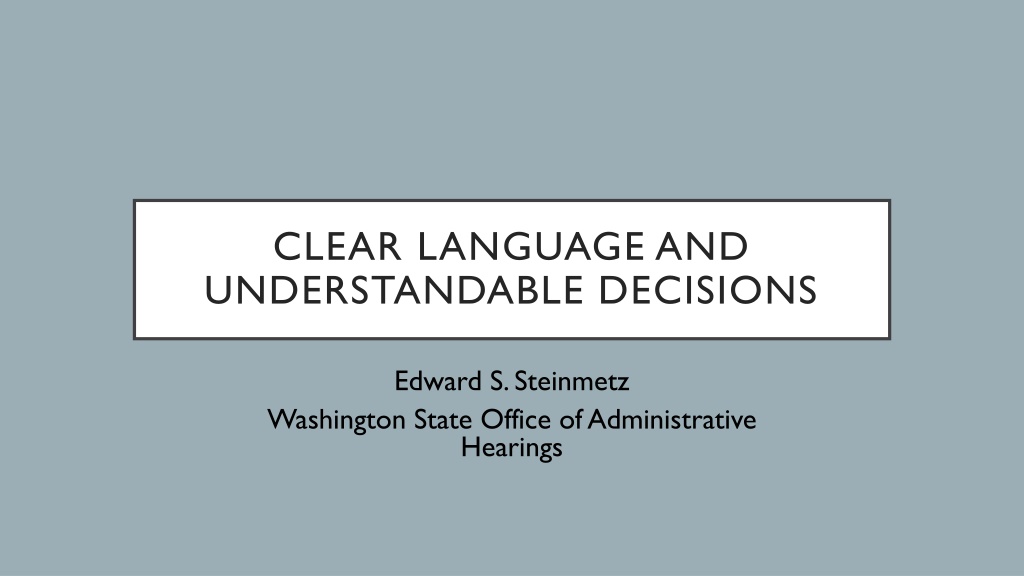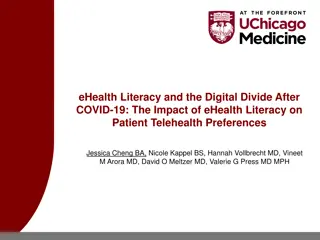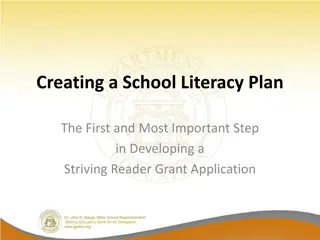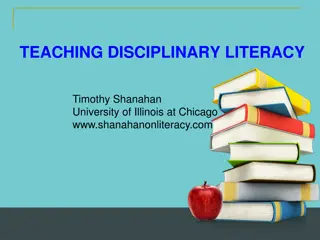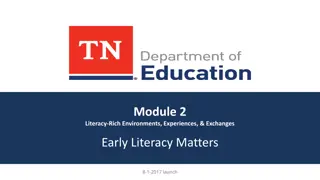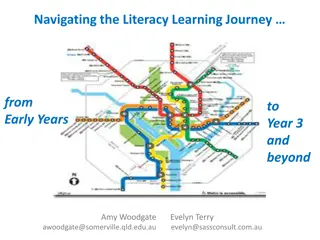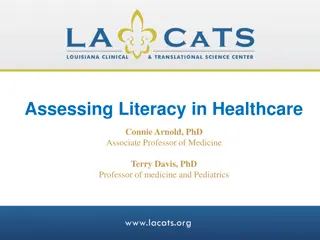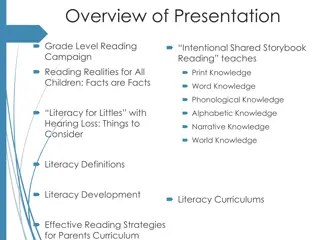Addressing Literacy Challenges in the United States
Literacy in the United States faces significant challenges, with a large percentage of adults struggling to read. This impacts employment opportunities and overall quality of life. The issue is also passed down to children, affecting their educational success. Adequate support and resources are needed to address these literacy gaps and provide opportunities for improved learning outcomes.
Download Presentation

Please find below an Image/Link to download the presentation.
The content on the website is provided AS IS for your information and personal use only. It may not be sold, licensed, or shared on other websites without obtaining consent from the author. Download presentation by click this link. If you encounter any issues during the download, it is possible that the publisher has removed the file from their server.
E N D
Presentation Transcript
CLEAR LANGUAGE AND UNDERSTANDABLE DECISIONS Edward S. Steinmetz Washington State Office of Administrative Hearings
LITERACY IN THE UNITED STATES US population 330,347,438 as of March 1, 2020. 77.5% of Americans are adults, (256,019,264). Approximately 32 million adults in the United States can t read. U.S. Department of Education. 50 percent of adults in the U.S. can t read a book written at an eighth-grade level. Organization for Economic Cooperation and Development. (128,009,632) 21 percent of adults in the U.S. read below a fifth-grade level. (53,764,045) 20 percent of high school graduates in the U.S. are functionally illiterate and cannot read. The reading skills of American adults are significantly lower than those of adults in most other developed countries, according to a new international survey. What s more, over the last two decades Americans reading proficiency has declined across most age groups, and has only improved significantly for 65-year-olds. Organization for Economic Cooperation and Development. The unemployment rate is 2 4 times higher among those with little schooling than among those with Bachelor s degrees. The Washington Post, 11/1/16. Seventy percent of adults with the lowest literacy skills are unemployed or work in part-time jobs. Policy Almanac.Org.
LITERACY IN THE UNITED STATES Literacy is considered learned. Illiteracy is passed along by parents who can not read or write. One in four children grow up not knowing how to read. To succeed at reading, a child must be able to identify or "read" printed words and to understand the story or text composed of those words. Both identifying words and understanding text are critical to reading success. For many children, increasing reading and school success will involve increasing oral language competence in the elementary years. During elementary school, a child's maximum level of reading comprehension is determined by the child's level of listening comprehension.
LITERACY IN THE UNITED STATES Later, adolescents and adults may comprehend more complex printed narrative or expository text than spoken text because print remains after reading and can be reviewed, while oral language usually cannot be reviewed. However, children must reach the point where they can understand printed text as well as spoken text before their comprehension of printed text can exceed their comprehension of spoken text.
LITERACY IN THE UNITED STATES About 50 percent of the 2 million immigrants that come to the U.S. each year lack high school education and proficient English language skills. This severely limits their access to jobs, college, and citizenship and increases their vulnerability to living in poverty. Center for Immigration Studies, National Commission on Adult Literacy. Adult education is in critical need for services. A decline in federal and state funding in the past 10 years has resulted in programs serving only a fraction of the adults in need.Currently,two-thirds of adult education programs are struggling with long student waiting lists.At the present levels of public funding, less than 10 percent of adults in need are receiving services. ProLiteracy: Member Statistical Report.
OAH SURVEY RESULTS Comments related to whether the hearing was easy to understand: A LOT OF LEGAL TERMS! No because legal jargin (sic) is difficult. Would like it to be in easier to understand terms. Terminology was kind of hard to understand. Legal language confusing. Lack of knowledge of process should have an attorney. Most humiliating experience. A lot of Law jargon used, felt lost among that conversation.
OAH SURVEY RESULTS Comments related to whether the written decision was easy to understand: Unable to tell whether ruling was in my favor or not. I don t understand legal-ize (sic) but I understood the outcome so yes. Legal jargon was hard. Couldn t figure out what the decision was. Had to read through it several times as there is too much legal terminology. Did not get the actual decision until page 3 of the Order. Could be more clearly stated at the beginning of the Order what the outcome was. Could not understand half of it.
CRITERION 7: CLEAR LANGUAGE PURPOSE - Throughout the hearing, the hearing officer should use language that is clear and understandable, avoiding unnecessary legal phrases and technical language. SCORING SEGMENT Good (6): The hearing officer's language was clear and understandable at all times, with the possible exception of inconsequential instances. There was no unnecessary use of legal phrases or technical language. Fair (3): There were minor instances when the hearing officer's language was not clear and understandable, or legal phrases or technical language was used. "Minor instances" would be confined to those that would not have a significant bearing on the outcome of the case.
CRITERION 7: CLEAR LANGUAGE Unsatisfactory (0): The hearing officer's language was not clear and understandable in significant and critical areas or unnecessary legal phrases and technical language was used at critical points in the hearing. REFERENCE NOTES - CRITERION 7. The intent of this criterion is to ensure that the hearing and all discussion with parties is clear and understandable, and that the parties are not confused by legal phrases or technical language.
CRITERION 7: CLEAR LANGUAGE When it appears a party or witness does not understand what is being communicated or asked, the hearing officer has the responsibility to tactfully ask the party or witness if he or she understands, and rephrase statements or questions, if necessary. References to form numbers and agency jargon should be avoided.
CRITERION 31: UNDERSTANDABLE DECISION PURPOSE -The decision should be worded so that it is understandable to most claimants and employers and it should have a professional appearance. SCORING SEGMENT Good (6): The language used in the decision contains words that are easy to understand to the average reader, avoids unnecessary legal jargon, technical verbiage or other shop talk, and contains no or limited grammatical, typographical or other errors. The decision is clear and concise and avoids using objectionable or abrasive words or phrases. The decision is neat and professional in appearance.
CRITERION 31: UNDERSTANDABLE DECISION Fair (3): The decision contains some legal jargon, or technical verbiage or some unfamiliar words, or contains some grammatical, typographical or other errors, but these did not substantially impair the average reader in understanding the decision. Unsatisfactory (0): The decision contains uncommon words that could not be easily understood by the average reader. The decision contained too much legal jargon, technical verbiage or shop talk such that the reader was left without a clear understanding of the rationale or outcome of the decision, or the decision contained such numerous grammatical, typographical or other errors that they adversely affected the coherence of the decision.
CRITERION 31: UNDERSTANDABLE DECISION REFERENCE NOTES - CRITERION 31. The intent of this criterion is to ensure that the hearing officer issues a written decision that can be understood by the parties and the agency. The decision must be clear, concise and worded in plain English to the level of understanding of most people. It should be written clearly and tactfully, and should appear neat and professional.
CRITERION 31: UNDERSTANDABLE DECISION A "Good" score is achieved when the language used in the decision is understandable to ordinary persons, is clear, tactful and concise, and the decision is free of all but minor grammatical, typographical or other errors. A deduction will not be made when the hearing officer cites a statutory provision, or court case, if there was some attempt to explain it in terms the ordinary person will understand.
CRITERION 31: UNDERSTANDABLE DECISION A "Fair" score should be given if the decision meets the qualifications above except that it contains some words that may be difficult for readers to understand, uses some legal jargon or technical verbiage without an attempt to explain these terms so that the average person can understand them, and/or contains some grammatical, typographical or other errors but these do not significantly impair the ability of the reader to understand the rationale or outcome of the decision.
CRITERION 31: UNDERSTANDABLE DECISION An "Unsatisfactory" score is warranted when the decision uses overly complex words or phrases that are not easily understood by the average person, or overly resorts to unnecessary legal jargon, technical verbiage or shop talk that significantly detracts from the reader s ability to understand the decision rationale or outcome, or which contains such numerous grammatical, typographical or other errors that reflect negatively on the reader s ability to have confidence in the decision. Simply put, if after reading the decision, the reader does not know who prevailed and why, the criteria should be scored "Unsatisfactory."
CRITERION 28: LOGICAL REASONING PURPOSE - The decision should state logical reasons for the outcome that are consistent with the findings of fact and the conclusions of law. SCORING SEGMENT Good (6): The hearing officer stated logical reasons for the decision consistent with the findings of fact and applied those facts in a logical manner to the conclusions of law. Fair (3): The reasoning was not fully stated or contained some inconsistencies but, when read as a whole, the decision is understandable both factually and legally.
CRITERION 28: LOGICAL REASONING Unsatisfactory (0): The reasoning and rationale in the decision were not stated or did not logically follow from the findings of fact to the conclusions of law.
CRITERION 28: LOGICAL REASONING REFERENCE NOTES - CRITERION 28. The intent of this criterion is to measure how well the decision is written such that a reasonable person will know upon reading the decision that it has a sound basis, in law and fact, for the outcome. The intent is not to second guess the decision of the hearing officer. Whether reasonable minds might differ in the outcome is not the standard. The reasoning in the decision cannot be inconsistent with the findings of fact or the conclusions of law applied. The explanation of the decision should be reasonably drawn from the findings of fact, be understandable, and adequately covers only the factors in the provision of the law relating to the issue.
CRITERION 28: LOGICAL REASONING The reasoning should be consistent with the findings of fact and the conclusions of law. The reasoning should use clear, concise, and understandable terms without unnecessary elaboration, and without reliance upon immaterial considerations. The facts should not be repeated as reasoning, nor should new facts be entered. The reasoning should include an explanation to the parties why material contentions were either accepted or rejected, and explain the basis for it.
CRITERION 28: LOGICAL REASONING A Good score is given when the reasoning of the hearing officer is clear in the decision, including that the findings of fact and conclusions of law are consistent and relevant to the material issues. Deduction will not be made when the hearing officer addresses specific legal or factual contentions raised by the parties. A "Fair" score may be given when, after consideration of all the facts and law, the reasoning is understandable and has a rational basis in law and fact even though there may be some minor inconsistencies or some incompleteness is addressing minor points. An "Unsatisfactory" score should be given when the reasoning is not clearly stated, or when the reasoning is inconsistent with the law and facts of the case, or when there is such incompleteness in analysis or so many internal inconsistencies that it is difficult to understand the outcome.
